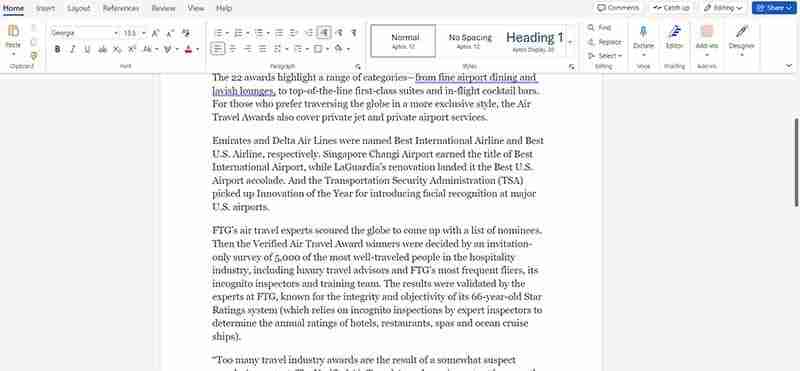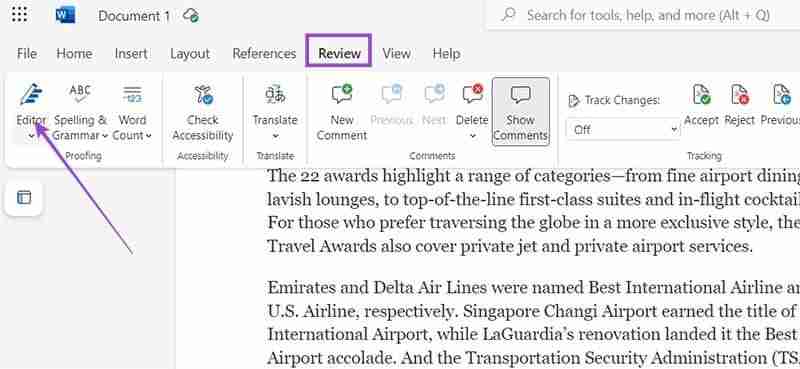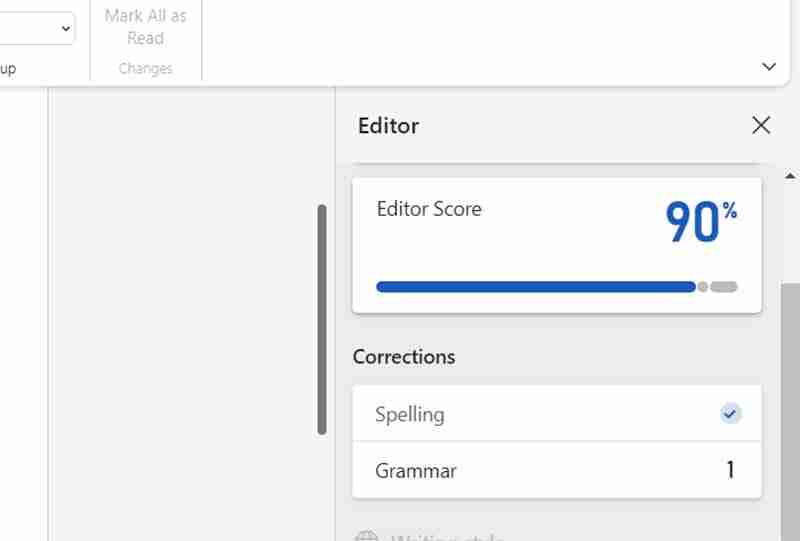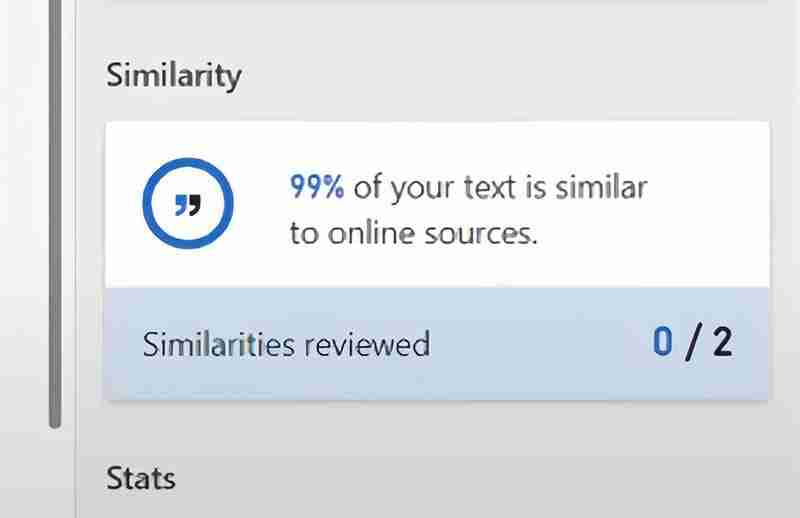How to Activate Microsoft Word's Plagiarism Checker
Whether you’re a student writing an essay, a professional writing some web copy for your site, or a blogger preparing a post, it’s important to avoid plagiarism. Not only is it bad practice to copy other people’s work, but it can also lead to various penalties and problems.
Microsoft Word has a helpful plagiarism checker, called the “Similarity Detector” built-in to help with this. Here’s how to use the Word plagiarism checker.
How to Use Word Plagiarism Checker
You can access the Word Similarity Detector in Word 365, Office 365, or Word for the web. If you’re using an older version of Word, like Word 2010, it won’t be available. So, check that you’re working with the right version of Word first of all, then proceed to follow these steps.
Step 1. Open the document you want to check for plagiarism.

Step 2. Find the “Editor” button. It’s in the top-right corner on the “Home” tab. Or, you can switch to the “Review” tab and find it there as well, on the left side.

Step 3. Click on “Editor” to open up the Editor menu. It’ll appear on the right side and show various bits of information about your text, including a percentage “Editor Score” and info about any spelling or grammar issues you need to fix.

Step 4. Scroll down in the Editor menu to find the part labeled “Similarity” and click the button marked “Check for similarity to online sources.” Then, wait a moment while the Editor scans your text against various online sources to see if any of it is too similar or directly copied. It’ll eventually give you a percentage score, showing how much of the text (if any) seems plagiarized.

Step 5. You can then review the text and hover your mouse over various sections to see which parts have been flagged for similarity. Then, it’s up to you to either cite your sources or rewrite and replace the offending sections. Note that after you make changes, your “Similarity Checker” score should decrease the next time you run it. You can run the checker as often as you like.
Benefits of the Word Plagiarism Checker
Here’s why you might like to make the Word plagiarism checker one of your go-to tools when working in Word.
Avoiding Plagiarism Penalties
Plagiarism often doesn’t go unpunished. If you’re a student and hand in a plagiarized piece of work, for example, you could end up with a fail grade or have to repeat the assignment. If you try to post plagiarized content online, too, Google can detect it, leading to a negative impact on your SEO and ranking.
By scanning for plagiarism and then removing sections that are copied from other sources from your work, you’ll be able to evade these problems.
Working with AI-Generated Text
Nowadays, there are many generative AI tools you can use to create content quickly and conveniently. You can ask an AI bot to write something for you, then copy it over into Word and continue to expand on it or edit it.
However, AI draws most of its knowledge from online sources. As such, it might directly copy certain passages or paraphrase info from the web. Using the Word plagiarism checker helps you avoid plagiarism accusations in AI-generated content.
The above is the detailed content of How to Activate Microsoft Word's Plagiarism Checker. For more information, please follow other related articles on the PHP Chinese website!

Hot AI Tools

Undresser.AI Undress
AI-powered app for creating realistic nude photos

AI Clothes Remover
Online AI tool for removing clothes from photos.

Undress AI Tool
Undress images for free

Clothoff.io
AI clothes remover

AI Hentai Generator
Generate AI Hentai for free.

Hot Article

Hot Tools

Notepad++7.3.1
Easy-to-use and free code editor

SublimeText3 Chinese version
Chinese version, very easy to use

Zend Studio 13.0.1
Powerful PHP integrated development environment

Dreamweaver CS6
Visual web development tools

SublimeText3 Mac version
God-level code editing software (SublimeText3)

Hot Topics
 1377
1377
 52
52
 win11 activation key permanent 2025
Mar 18, 2025 pm 05:57 PM
win11 activation key permanent 2025
Mar 18, 2025 pm 05:57 PM
Article discusses sources for a permanent Windows 11 key valid until 2025, legal issues, and risks of using unofficial keys. Advises caution and legality.
 win11 activation key permanent 2024
Mar 18, 2025 pm 05:56 PM
win11 activation key permanent 2024
Mar 18, 2025 pm 05:56 PM
Article discusses reliable sources for permanent Windows 11 activation keys in 2024, legal implications of third-party keys, and risks of using unofficial keys.
 Acer PD163Q Dual Portable Monitor Review: I Really Wanted to Love This
Mar 18, 2025 am 03:04 AM
Acer PD163Q Dual Portable Monitor Review: I Really Wanted to Love This
Mar 18, 2025 am 03:04 AM
The Acer PD163Q Dual Portable Monitor: A Connectivity Nightmare I had high hopes for the Acer PD163Q. The concept of dual portable displays, conveniently connecting via a single cable, was incredibly appealing. Unfortunately, this alluring idea quic
 Top 3 Windows 11 Gaming Features That Outshine Windows 10
Mar 16, 2025 am 12:17 AM
Top 3 Windows 11 Gaming Features That Outshine Windows 10
Mar 16, 2025 am 12:17 AM
Upgrade to Windows 11: Enhance Your PC Gaming Experience Windows 11 offers exciting new gaming features that significantly improve your PC gaming experience. This upgrade is worth considering for any PC gamer moving from Windows 10. Auto HDR: Eleva
 This Wild Ultra-Wide Alienware Monitor is $300 Off Today
Mar 13, 2025 pm 12:21 PM
This Wild Ultra-Wide Alienware Monitor is $300 Off Today
Mar 13, 2025 pm 12:21 PM
Alienware AW3225QF: The best curved 4K display, is it worth buying? The Alienware AW3225QF is known as the best curved 4K display, and its powerful performance is unquestionable. The fast response time, stunning HDR effects and unlimited contrast, coupled with excellent color performance, are the advantages of this monitor. Although it is mainly aimed at gamers, if you can accept the shortcomings of OLED, it is also suitable for office workers who pursue high efficiency. Widescreen monitors are not only loved by gamers, but also favored by users who value productivity improvement. They are great for work and enhance anyone’s desktop experience. This Alienware monitor is usually expensive, but is currently enjoying it
 How to Create a Dynamic Table of Contents in Excel
Mar 24, 2025 am 08:01 AM
How to Create a Dynamic Table of Contents in Excel
Mar 24, 2025 am 08:01 AM
A table of contents is a total game-changer when working with large files – it keeps everything organized and easy to navigate. Unfortunately, unlike Word, Microsoft Excel doesn’t have a simple “Table of Contents” button that adds t
 ReactOS, the Open-Source Windows, Just Got an Update
Mar 25, 2025 am 03:02 AM
ReactOS, the Open-Source Windows, Just Got an Update
Mar 25, 2025 am 03:02 AM
ReactOS 0.4.15 includes new storage drivers, which should help with overall stability and UDB drive compatibility, as well as new drivers for networking. There are also many updates to fonts support, the desktop shell, Windows APIs, themes, and file
 Shopping for a New Monitor? 8 Mistakes to Avoid
Mar 18, 2025 am 03:01 AM
Shopping for a New Monitor? 8 Mistakes to Avoid
Mar 18, 2025 am 03:01 AM
Buying a new monitor isn't a frequent occurrence. It's a long-term investment that often moves between computers. However, upgrading is inevitable, and the latest screen technology is tempting. But making the wrong choices can leave you with regret




